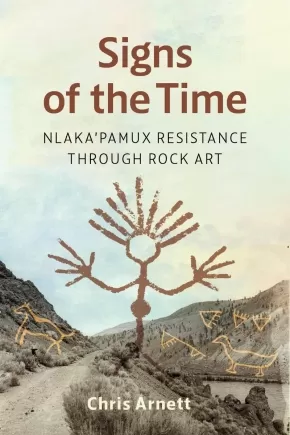Chris Arnett
Author and carver Chris Arnett is a fourth-generation British Columbian on his mother’s side and a member of the Ngai Tahu, a New Zealand Maori tribe, on his father’s side. With a life-long interest in the pre-history and history of British Columbia and New Zealand, he has researched the archeology of the Stein River Valley for the ‘Nlaka’pamux Nation Development Corporation and has worked for the Sooke Region Museum and Archives on a historical survey of logging on Vancouver Island’s southwest coast, which was published in 1989.
Books (2)
Synopsis:
Rock art – etched in blood-red lines into granite cliffs, boulders, and caves – appears as beguiling, graffiti-like abstraction. What are these signs? The petroglyphs and red-ochre pictographs found across Nlaka’pamux territory in present-day British Columbia and Washington State are far more than a collection of ancient motifs.
Signs of the Time explores the historical and cultural reasons for making rock art. Chris Arnett draws on extensive archival research and decades of work with Elders and other Nlaka’pamux community members, their oral histories and oral tradition, to document the variability and similarity of practices. Rock art was and is a form of communication between the spirit and physical worlds, a way to pass information to later generations, and a powerful protection against challenges to a people, land, and culture.
Nlaka’pamux have used such culturally prescribed means to forestall external threats to their lifeways from as early as the sixteenth century – when they were aware of incipient European encroachment – until well into the twentieth. As this important work attests, rock art remains a signature of resilience and resistance to colonization among Nlaka’pamux today.
As well as providing essential reading for scholars and students of archaeology, cultural and applied anthropology, Indigenous studies, and art history, Signs of the Time will also fascinate rock art specialists and amateur enthusiasts.
Reviews
"Signs of the Time is innovative and provocative, adding dramatically to the discussion of how Western science interacts with and accommodates Indigenous knowledge, concerns, and heritage." — David S. Whitley, author of Cave Paintings and the Human Spirit: The Origin of Creativity and Belief
"Signs of the Time is informative and accessible, giving equal voice to Indigenous knowledge keepers and academics in presenting the ideas in petroglyphs and pictographs. It is an excellent example of how Eurowestern academics can work alongside Indigenous knowledge experts to understand the Indigenous world. I highly recommend it." — Lorna Wanosts’a7 Williams EdD; OC; OBC; Lil’watul; professor emerita, University of Victoria
Additional Information
256 pages | 6.00" x 9.00" | 40 b&w photos
Synopsis:
In They Write Their Dreams on the Rock Forever, ‘Nlaka’pamux elder Annie York explains the red-ochre inscriptions written on the rocks and cliffs of the lower Stein Valley in British Columbia. This is perhaps the first time that a Native elder has presented a detailed and comprehensive explanation of rock-art images from her people’s culture. As Annie York’s narratives unfold, we are taken back to the fresh wonder of childhood, as well as to a time in human society when people and animals lived together in one psychic dimension.
This book describes, among many other things, the solitary spiritual meditations of young people in the mountains, once considered essential education. Astrological predictions, herbal medicine, winter spirit dancing, hunting, shamanism, respect for nature, midwifery, birth and death, are some of the topics that emerge from Annie’s reading of the trail signs and other cultural symbols painted on the rocks. She firmly believed that this knowledge should be published so that the general public could understand why, as she put it, “The Old People reverenced those sacred places like that Stein.”
They Write Their Dreams on the Rock Forever opens a discussion of some of the issues in rock-art research that relate to “notating” and “writing” on the landscape, around the world and through the millennia. This landmark publication presents a well-reasoned hypothesis to explain the evolution of symbolic or iconic writing from sign language, trail signs and from the geometric and iconic imagery of the dreams and visions of shamans and neophyte hunters. This book suggests that the resultant images, written or painted on stone, constitute a Protoliteracy which has assisted both the conceptualization and communication of hunting peoples’ histories, philosophies, morals and ways life, and prepared the human mind for the economic, sociological and intellectual developments, including alphabetic written language.
Additional Information
320 pages | 6.75" x 9.75" | 2nd Edition








